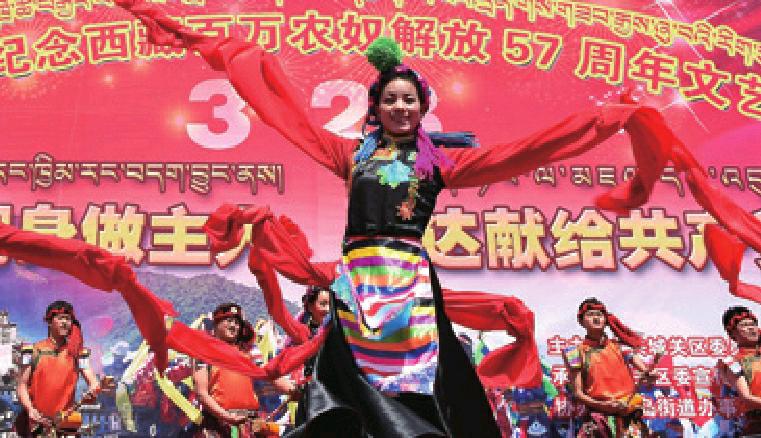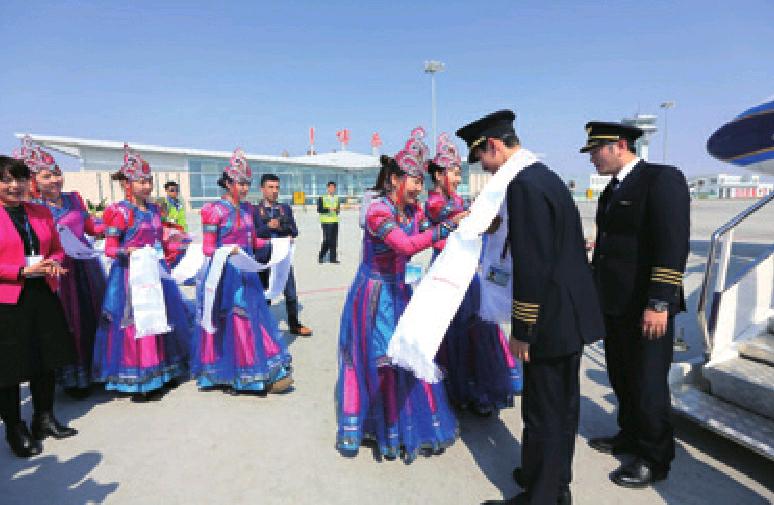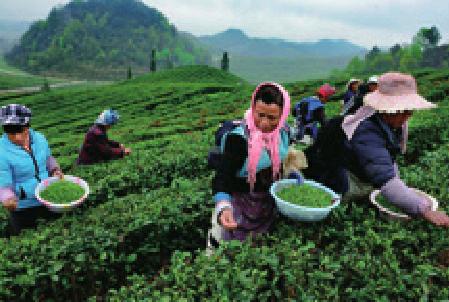Grand Celebration
2016-04-13
Dancers perform at an event marking Serfs Emancipation Day in Lhasa, Tibet Autonomous Region, on March 28.
In 2009, March 28 was designated as the day to mark the freeing of 1 million people, or 90 percent of the regions population at that time, from the feudal serf system in 1959.
Child Census
China will carry out a nationwide census on rural left-behind children, those whose parents work away from home, to ensure proper arrangements are being made for their lives and education.
The census, which began on March 29 and will go until the end of July, covers rural children under the age of 16 whose parents are not their main caregiver, according to Wang Jinhua, an official with the Ministry of Civil Affairs (MCA).
A statement issued by the MCA said that surveyors will collect information on the number of these children, where they live, their family composition and education level. Information about their health and their family members source of income will also be gathered.
According to the statement, the authorities will establish a database that will support the drafting and implementation of policies for leftbehind children.
In addition, civil affairs authorities will survey rural women who live separately with their husbands, and the elderly in the countryside, to give them better support, the statement said.
No Paid Service
The Central Military Commission(CMC), the highest authority that runs Chinas armed forces, plans to gradually terminate all paid services in the military in three years, according to a CMC circular recently issued.
According to the document, military units will no longer be allowed to launch new programs or sign new contracts for paid services, and expired contracts may not be renewed.
The CMC also rolled out principles and measures on the termination of military paid services, aiming to tackle problems that may emerge as a result of the move.
In late 2015, China initiated a new round of military reforms. Paid services were flagged for removal to reduce corruption in the army.
Research Support
China will use its science fund to further develop basic science research and elevate the reputation of its academic papers, scientists, cutting-edge programs and research achievements, said a senior official. In the 2016-20 period, the science fund will support the exposure of academic papers, to make them the second most cited globally, according to Yang Wei, head of the National Natural Science Foundation of China (NSFC) that manages the fund, on March 29. He also announced goals that Chinese will account for at least 10 percent of the worlds highly cited scientists and that the average number of Chinese theses being cited approaches the global average.
Yang said that the country will conduct around 10 cutting-edge programs every year by 2020.
During the 2011-15 period, the science fund financed nearly 200,000 programs, with around 88.8 billion yuan ($13.71 billion) from state revenue and more than 1.7 billion yuan ($262 million) from other sources, NSFC figures showed.
In 2014, China had 5,505 scientific theses carried by the most recognized international periodicals, ranking second in the world, 55.6 percent of which received funding from the science fund, according to the NSFC.
In 2016, the science fund has, thus far, received 172,913 applications, up 4.42 percent year on year.
Relief Plan
China unveiled a revised disaster relief plan on March 24 to fine tune its ability to deal with rescue missions. It is the second time the national disaster relief plan has been amended since the program was introduced in 2005. The other revision was in 2011.
The National Committee for Disaster Reduction is responsible for organizing and instructing disaster rescue, according to the new plan issued by the General Office of the State Council.
The document also specifies duties and responsibilities of the committees member agencies, including damage reporting, releasing information and mobilizing the public to participate in rescue missions.
According to the relief plan, China has a four-level emergency response system, with Level 1 being the top emergency response and Level 4 the lowest.
Natural disasters left about 1,500 people dead or missing in China each year between 2011 and 2015, according to statistics released by the Ministry of Civil Affairs.
It was also reported that disasters affected 310 million people each year during the same period, displaced more than 9 million people and destroyed 700,000 houses. The annual direct economic losses amounted to 380 billion yuan ($58.3 billion).
Disability Rehab
Disabled people will be able to receive medical refunds on 20 more rehab programs, according to the China Disabled Persons Federation.
The programs, for people with physical, mental, verbal and hearing disabilities, should be covered by the basic medical insurance reimbursement program by June 30.
The new additions include a variety of evaluation and therapy techniques for both children and the elderly.
Since 2010, nine such programs have been covered by the insurance reimbursement program.
Higher Return
Chinas social security fund manager on March 25 said that its return on investment for 2015 was 15.1 percent, up from 11.4 percent in 2014, despite downward economic pressure.
The National Council for the Social Security Fund earned 228.7 billion yuan ($35.1 billion) from all investment last year, according to a statement on its website.
The rate of return outperformed the average level of 8.4 percent for the period from the funds establishment in 2000 to 2014.
The fund is designed to serve as a solution to the countrys aging problem, as well as a strategic reserve to support future social security expenditures. It has invested in a variety of financial products both at home and abroad, including fixedincome assets and stocks.
By the end of 2015, the fund had managed assets totaling 1.9 trillion yuan ($293 billion), up from 1.5 trillion yuan ($232 billion) a year earlier.
The fund manager vowed to improve the management on investments and raise more money this year to ensure the fund continues to appreciate.
Joint Institute
China has established a joint research center on the South China Sea to strengthen academic and institutional exchanges and promote countries in the region to jointly maintain peace and stability in the sea.
The China-Southeast Asia Research Center on the South China Sea (CSARC), which was inaugurated on March 25, involves well-known think tanks in China and Southeast Asian nations such as Chinas National Institute for South China Sea Studies and Indonesias Center for Strategic and International Studies.
“We plan to make the CSARC a platform for discussing the South China Sea issue and a model for maritime research cooperation among countries in the region,”said Wu Shicun, President of Chinas National Institute for South China Sea Studies.
Wu said the CSARC will invite famous scholars on the South China Sea from home and abroad to be researchers, and it plans to hold frequent international symposiums and academic exchanges.
Chinese Fashion
Models present creations by designer Xu Qingyin during the China Fashion Week in Beijing on March 28.
Originated in 1997, China Fashion Week is a biannual international event held at various venues in Beijing, hosting professional contests, exhibitions, fashion forums and professional evaluations.
Sowing Season
Farmers plant cotton in a field in Bayingolin Mongol Autonomous Prefecture, Xinjiang Uygur Autonomous Region, on March 27.
Overseas Students
Statistics from the Ministry of Education (MOE) showed that as of the end of 2015, 4.04 million Chinese students had studied or were studying overseas since the country opened up to the world in 1978.
In a recent report about employment of students who have returned home, the ministry said that a total of 2.22 million students had come back.
In 2015, over 520,000 Chinese students went abroad for study, and 409,100 came back.
Most of the returnees, about 75 percent of interviewees, were willing to work in eastern coastal cities, and 3.32 percent of them hope to start their own businesses. Career development opportunities are the most important factor for them in choosing jobs, followed by location and salary.
Students who majored in management, science and economics are in greatest demand when they come back to China, followed by those who majored in engineering, arts and laws.
Qi Mo, an MOE official, said that 97 percent of students were studying abroad at their own expense.
Pricing Reform
In a bid to open the electricity industry, China will expand its power pricing reform nationwide in 2017 following a two-year pilot period in several regions, according to official sources.
The transmission and distribution pricing system reform will be pushed forward for all power grid operators nationwide next year, Zhang Manying, an official with the National Development and Reform Commission (NDRC), said during a press conference on March 29.
First rolled out in Shenzhen, Guangdong Province, in 2014 and then introduced to five more regions last year, the reform aims to remove official interference in price determination and grant the market a decisive role.
Complaints have increased among users in recent years that current controls on electricity rates allow state-owned power grid companies to make large profits and add to the burden of consumers. The prices are expected to go down as a result of the reform.
Zhang estimated around 5.56 billion yuan ($855 million) will be saved for power users in the five regions that participate in the pilot program.
The NDRC announced in March that the reform will be expanded to 12 more provincial-level power grid companies and one regional network operator in 2016, including Beijing, Tianjin, Chongqing and Guangdong.
New Flight Unveiled
Mongol women present ceremonial hada scarves to crew members of the inaugural flight from Wuhan, Hubei Province, at an airport in Bole, Xinjiang Uygur Autonomous Region, on March 28.
The same day, China Southern Airlines launched the Wuhan-Bole air route.
Advanced Manufacturing
The China Railway Rolling Stock Corp. (CRRC) started the construction of a 10-billion-yuan ($1.54 billion) smart-equipment manufacturing center on March 27.
The companys new ecofriendly industrial park is located in the Kaiping Development Zone in Tangshan, north Chinas Hebei Province.
The park covers an area of 120 hectares and will act as a hub for energy-saving and smart-equipment manufacturing industries, thanks in large part to a 3.3-billion-yuan ($510 million) investment in the first phase.
The premises will include a new-energy equipment center, an export base for Central and Eastern Europe, bases for research and development, as well as water treatment equipment.
In the next five years, the CRRC plans to put no fewer than 1,500 new-energy vehicles on Tangshans roads.
Formed through the merger of former rivals China North Railway and China South Railway, Beijingbased CRRC is the worlds largest supplier of rail transit equipment. Its products have been exported to about 100 countries and regions.
Done Deal
On March 29, Bangladesh signed an engineering, procurement and construction contract with a consortium of two Chinese firms for the installation of a $1.56-billion coalfired power plant in the country.
Officials with the consortium of Chinese firms—the First Northeast Electric Power Engineering Co. and the China Energy Engineering Group Co. Ltd.—and the BangladeshChina Power Co. Ltd. (BCPCL), a joint venture of China National Machinery Import and Export Corp. and Bangladeshs North-West Power Generation Co. Ltd., signed the agreement on behalf of their respective sides.
The consortium of Chinese firms is assigned to develop the plants engineering, procurement and construction while the BCPCL is its executing agency.
Bangladesh and China set up the BCPCL to implement the project at Payra in the district of Patuakhali, some 204 km south of the capital, Dhaka, near the Payra maritime port.
According to a press release, the 1,320-MW power plant is scheduled to begin full operations by December 2019.
The plant, which will be built on a 397-hectare piece of land, is part of the Bangladeshi Governments plan to set up a series of coal-fired power projects to generate 20,000 MW electricity by 2030.
Spring Competition
Participants pick tea leaves during a contest in Anshun, southwest Chinas Guizhou Province, on March 29.
More than 100 contestants participated in the event, with tea picking, frying and tea art components.
New Tax Rules
China will change tax rules on cross-border online purchases from April 8 to level the playing field for e-commerce platforms and traditional retailers and importers.
Retail goods purchased online will no longer be classified as“parcels,” which enjoy a “parcel tax” rate that is lower than the rate on other imported goods. Instead, online purchases from overseas will be charged in the same way as any other imported goods, the Ministry of Finance (MOF) announced on March 24.
“Parcel tax is not for trade purposes, which is exactly what online retailing is. It is unfair to conventional importers and domestic producers,”said Zhang Bin, a researcher at the Chinese Academy of Social Sciences.
China levies a parcel tax on imported goods worth less than 1,000 yuan ($154) with the rate typically falling at 10 percent. Taxes under 50 yuan ($7.7) are waived. As demand for overseas commodities has increased, online purchasing agents have taken advantage of the parcel tax and used methods such as repackaging and mailing products separately to avoid paying the tax. The new policy allows a maximum of 2,000 yuan ($308) per single cross-border transaction and a maximum of 20,000 yuan($3,080) per person per year. Goods that exceed these limits will be levied the full tax for general trade, the MOF said.
AIIB Membership
There are more than 30 countries waiting to join the Asian Infrastructure Investment Bank (AIIB), in addition to its 57 founding members, the banks President Jin Liqun said on March 25.
The AIIB is working on accepting new members, Jin said during the Boao Forum for Asia Annual Conference 2016, which concluded on March 25 in south Chinas Hainan Province.
“I think the new member issue will be solved before the end of this year,” he noted.
A not-for-profit multilateral development bank initiated by China, the AIIB was officially established in December 2015 and began operating in January. It is due to unveil its first projects during the first half of this year.
Jin also said that it is possible for Chinas Hong Kong Special Administrative Region to become a member as a sub-sovereign government, based on the banks Articles of Agreement. Hong Kong representatives have been involved in the AIIB negotiations as part of the Chinese delegation.
As a major international banking center, Hong Kong will have a significant role to play, Jin said.
Energy Conservation
An energy-saving reconstruction project targeting 160 buildings in Urumqi, capital of northwest Chinas Xinjiang Uygur Autonomous Region, will be launched in June, local authorities said on March 28.
The project, covering an area of more than 1 million square meters, will retrofit the structures as well as heating, ventilation and electrical systems of public buildings, such as schools and hospitals.
The 696-million-yuan ($107 million) project was approved by the National Development and Reform Commission in March.
About 40 percent of the funding will come from the European Investment Bank, which sees the project as a way to promote development in an underdeveloped region, according to Feng Mei, an official with the Xinjiang Regional Development and Reform Commission.
“Less developed regions like Xinjiang will benefit from the loans because the loan repayment period is 20 years, with an annual interest rate of 1 percent,” Feng said.
The rest of the funds will be provided by the government of Xinjiang. The project is expected to be completed in 2019.
Independent R&D Fruit
Workers from the China Railway 11th Bureau Group Co. Ltd. lift CRTSIII ballastless track slabs out of water in Fengcheng, Jiangxi Province, on March 27. The slab is economical and performs well in endurability and quality stability. It is an achievement for Chinese science and technology with proprietary intellectual rights.
